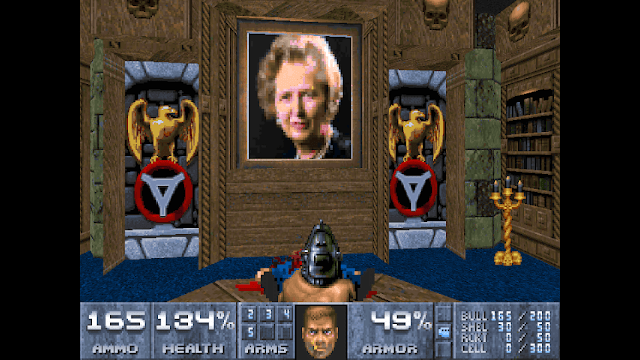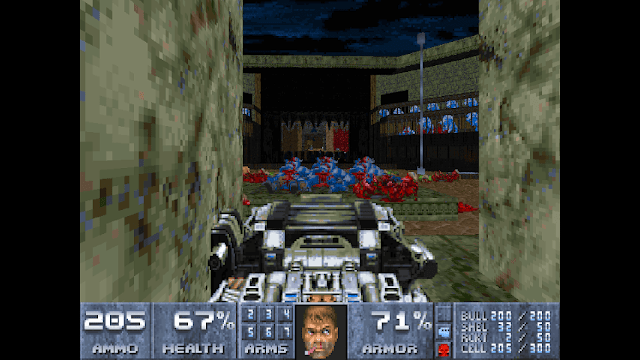Recently I've had a massive increase in free time and a major reduction in income, so I've been playing old games again. When I was younger I really liked Freedom Fighters, a 2003 squad based game. The setting is an alternative Cold War where the Soviet Union has successfully conquered the United States. The aim of the game is to liberate New York and drive out the invaders.
Now, Freedom Fighters is part of a proud tradition in Cold War fiction, where the Soviet Union is a powerful force for evil and oppression but aside from the flag and the red stars has no real political resemblance to the actual Soviet Union as it existed. They don't talk about socialism or the works of Lenin, you could swap them out with any generic imperial power. It also has a slightly cynical satirical edge to its humour. It's not a serious game with a serious political message other than freedom is good and invading other nations is bad.
At the time it was heavily acclaimed for exceptionally good squad AI, they would largely do what you told them, and would be very effective if you ordered them about appropriately. It also had an interesting approach to levels, each level was broken into multiple blocks with the objective being the destruction of all Soviet army forces within them. The unique twist was that you couldn't or at least weren't supposed to boot up the level and then just shoot your way to the end, walking over a pile of corpses. The game wanted you to act like an underdog urban guerrilla.
Playing it again, it reminded me a lot of a controversial military theory called Foco theory or Foquismo. Foquismo has largely faded from memory, but there was a time in the 1960s-80s in the midst of the Cold War where it was a popular strategy that inspired dozens of small groups of revolutionaries in Latin America and other parts. It's closely associated with Che Guevara, but was codified by Regis Debray, in the years before he became a comfortable member of the French establishment and adviser to French governments. Debray was an admirer of Guevara and based his military ideas on the experience of Guevara, which confuses me a bit because the Cuban revolution doesn't really reflect the ideas of Foquismo, but that's a discussion for another day.
Anyway, the way the game's combat mechanics work seems like it was originally designed as a training tool for a school of Foquista soldiers. Obviously that isn't the case and its just a coincidence, but nevertheless the parallels were striking to me.
A brief summary (simplified) of Foquismo:
- It is possible for a small band of dedicated and skilled armed fighters to defeat a standing army.
- By fighting against the army of a regime, this group can inspire and ignite a popular uprising.
- This means that the Foco, the Guerrilla army has replaced the party as the revolutionary vanguard and can exhilarate and establish the necessary conditions for social change and revolutionary struggle.
Again this is a simplification, Debray and every other advocate of Foquismo I've encountered added more to it and some qualifiers. A common one is that this strategy is only viable for "developing" nations with a still small proletariat, or in colonial and immediately-post colonial societies whose rulers haven't had time to cement their rule and establish their legitimacy fully. But these three points are what distinguish Foquismo from more orthodox Leninist and Maoist military strategy.
How did it work? Well to cut it short, terribly. They failed everywhere they tried, the People's Revolutionary Army in Argentina were exterminated, and the military used their failed campaign as justification to launch a general war of extermination against all dissident groups.
But of course Freedom Fighters isn't real, it's a video game, so things turn out a bit better for the Foco there. After the tutorial level you meet a skilled survivor called Mr, Jones who takes you to an already prepared base area hidden in the sewers. From there, you plan your counter-attacks. Each block is divided into three or four sections with detailed locations of Soviet forces, their checkpoints, armouries etc. What's interesting is that these sections while split into sublevels still have an effect on each other. Say you find yourself ripped apart by a Soviet Hind and cannot advance further, checking the map will reveal that in another section there is a helicopter refuelling station, moving to that part and blowing it up means the Hinds are no longer an issue. Or perhaps you keep getting spotted by snipers and patrols at night, in another section there's an electrical substation that's powering the search lights.
Instead of just marching to point A to point B, the game wants you to stay mobile using the sewers to constantly move between areas picking vulnerable enemy positions and thus whittle down their strength before finally driving them out of the area. Foquismo like most over theories on Guerrilla warfare stress the need for the outnumbered Guerrillas to stay moving and pick their battles, only taking on fights they should win. The weapons are either improvised, a wrench, a Molotov cocktail or taken from the enemy.
The way it handles squads is close to the logic of Foquismo. In addition to a green health bar, there is a yellow bar, this yellow bar is called charisma, and it governs how many freedom fighters you can recruit into your squad. You get charisma from fulfilling objectives, i.e. inspiring the population with your military exploits. In later levels you will find wounded Soviet soldiers, by healing them they come over to your side. This shows how the guerrillas have been inflicting more damage on the occupiers and have successfully demoralised some of the enemy troops.
Narratively speaking this is also mirrored, as you go on completing missions you become known as the "Freedom Phantom" a mythic hero who inspires the downtrodden. At one point in the game, your characters' brother leaves the base and New York as part of a mission to link up with other groups of freedom fighters to escalate the fighting into a general uprising.
The final act of the game involves the freedom fighters seizing a Soviet run TV channel and broadcasting messages to launch an uprising throughout New York. Then launching a final assault on the Soviet army base on Governors Island. You've gone from a tiny band of committed fighters to seizing most of the territory and leading a popular revolt.
And that's it, apart from an unlockable bonus level fighting on the Statue of Liberty, that is where the game ends. It never got a sequel or follow up, so we have no idea how the freedom phantom handled the fallout.





















.jpeg)








